How to determine if your supplier is compliant with all regulatory oversight?
Understanding the Foundations of Supplier Compliance
In today's interconnected global economy, ensuring that your suppliers meet all regulatory and oversight requirements is critical for maintaining operational integrity, safeguarding data, and protecting your company's reputation. This article provides a comprehensive guide on how organizations can determine whether their suppliers are compliant with relevant regulations, the key components of effective compliance programs, and best practices for ongoing monitoring and verification.
Defining Regulatory Compliance for Suppliers
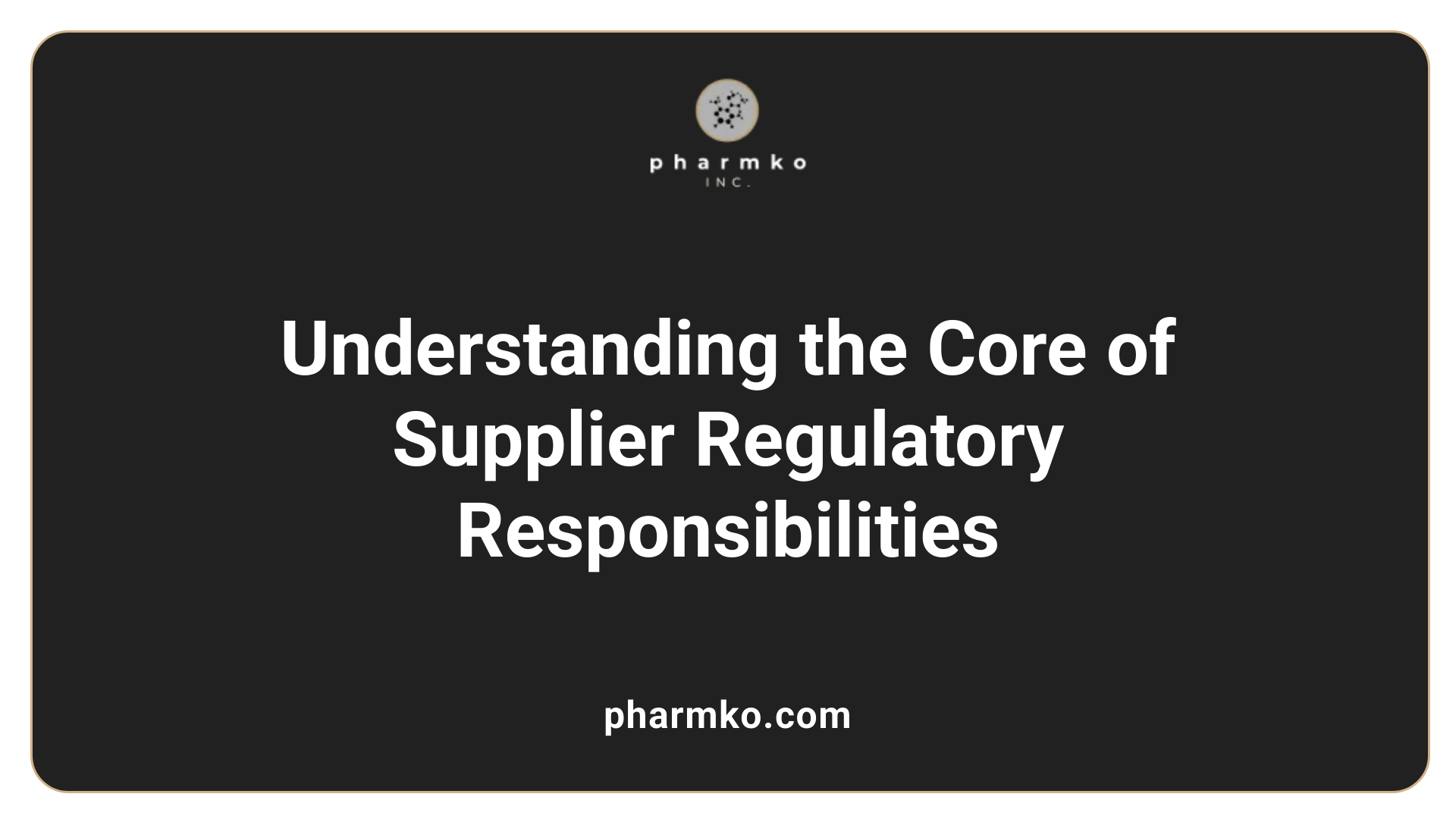
What does regulatory compliance entail for suppliers?
Regulatory compliance for suppliers means following all relevant laws, regulations, and standards that govern their industry and geographical location. This includes a wide range of legal obligations that ensure businesses operate ethically, securely, and within legal boundaries.
Suppliers must implement clear policies and procedures that promote adherence to these regulations. This involves conducting thorough risk assessments to identify potential compliance gaps, and providing ongoing employee training to ensure staff are aware of their responsibilities and any updates in regulatory requirements.
Monitoring systems are vital for maintaining compliance over time. Regular audits, performance reviews, and the use of compliance management tools enable suppliers to track their adherence and swiftly address any issues that arise. These measures help prevent violations that could lead to legal penalties, financial fines, or reputational damage.
Standards such as the General Data Protection Regulation (GDPR), the Health Insurance Portability and Accountability Act (HIPAA), the Payment Card Industry Data Security Standard (PCI DSS), and other industry-specific requirements are critical benchmarks. For example, GDPR emphasizes protecting personal data within the EU, while HIPAA sets standards for safeguarding healthcare information in the U.S.
Compliance is an ongoing process, not a one-time effort. It involves integrating frameworks like Governance, Risk Management, and Compliance (GRC), conducting regular internal and external audits, and leveraging specialized platforms that streamline compliance monitoring. These tools facilitate real-time tracking, reporting, and documentation of compliance activities.
Establishing robust compliance practices not only helps avoid legal and financial repercussions but also enhances supplier reputation and customer trust. In a landscape where regulatory expectations continually evolve, proactive management and adaptation are essential for sustained supplier success.
Strategies for Ensuring Supplier Compliance
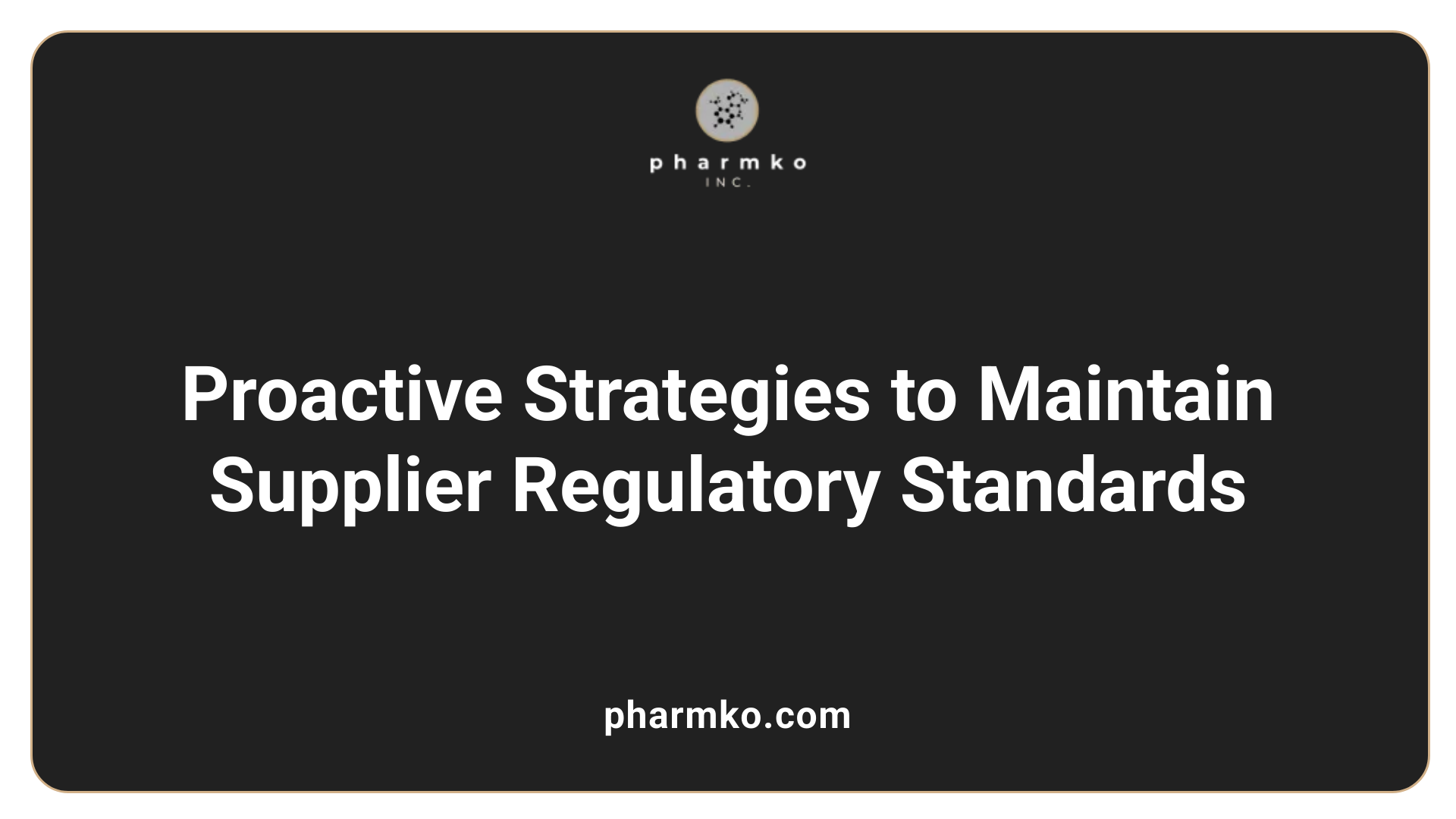
How can companies ensure that suppliers comply with relevant regulations and oversight?
Ensuring that suppliers adhere to industry standards and legal regulations is vital for maintaining a secure, ethical, and efficient supply chain. Companies must take deliberate steps to verify ongoing compliance and foster a culture of responsibility.
One of the foundational practices is establishing clear contractual obligations. These contracts should explicitly outline all compliance requirements relevant to the supplier's industry and geography. Including specific expectations regarding data privacy, cybersecurity standards, environmental standards, and human rights helps set transparent standards. Clearly written contracts also specify penalties for non-compliance, ensuring suppliers understand the consequences of failing to meet agreed-upon standards.
Regular audits, inspections, and performance reviews are essential for verifying adherence over time. Scheduled and surprise audits help identify gaps in compliance and uncover risks before they escalate. Performance metrics and KPIs focused on compliance aspects should be monitored consistently. These reviews can include documentation checks, site visits, and interviews with supplier staff.
Fostering transparency and open communication creates a partnership rather than a solely transactional relationship. Encouraging suppliers to share their compliance challenges and improvements builds trust. It enables quicker resolution of issues and aligns supplier operations with regulatory expectations.
Technology plays a significant role in streamlining compliance management. Utilizing compliance management systems and automation tools can improve reporting accuracy, reduce human error, and enable real-time monitoring. Platforms like Findings facilitate continuous oversight by aggregating supplier data, tracking compliance status, and generating alerts when issues arise.
Lastly, ongoing training and support are crucial. Regulations continually evolve, and suppliers need to stay informed about new requirements. Providing training programs, resources, and continual guidance ensures suppliers are equipped to meet changing standards. This proactive approach minimizes risks and reinforces a shared commitment to compliance.
By combining these strategies—clear contractual obligations, ongoing oversight, transparent communication, advanced technology, and continuous training—companies can effectively manage supplier compliance and safeguard their supply chains.
Continuously Monitoring and Verifying Compliance
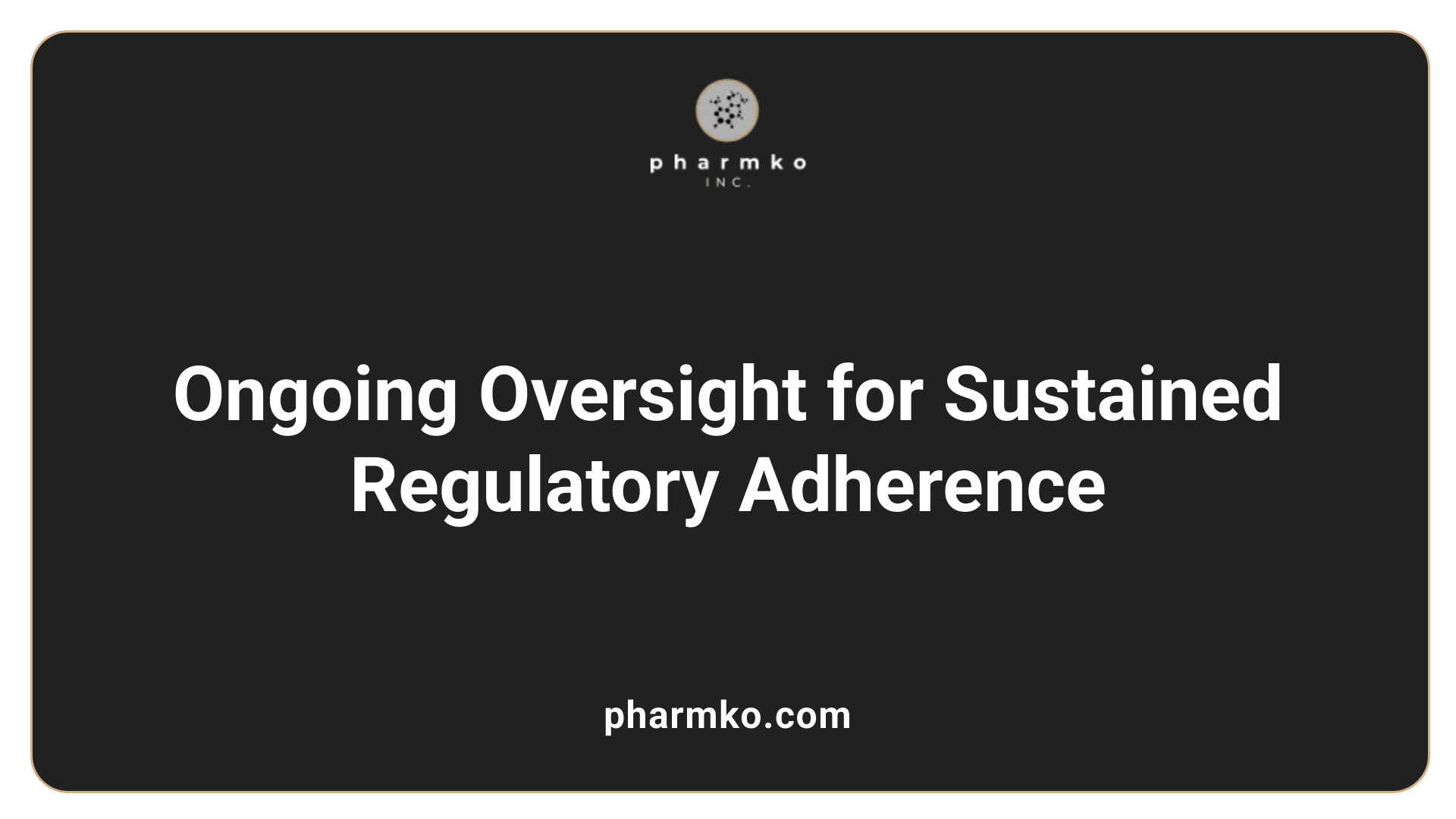
How can organizations monitor and verify regulatory compliance among suppliers?
Maintaining compliance within a supply chain is an ongoing process that requires diligent monitoring and regular verification. Organizations employ a mix of risk assessments, internal and external audits, and standardized monitoring plans to keep track of supplier adherence to regulatory standards.
One of the most effective strategies involves leveraging advanced technology solutions. Compliance management software platforms automate many aspects of compliance verification, including tracking certifications, monitoring changes in regulations, and generating real-time reports. These systems help reduce manual errors and allow organizations to respond swiftly to compliance issues.
Real-time monitoring tools further enhance oversight by continuously collecting data from suppliers. These tools can alert managers to potential non-compliance events, such as deviations from quality standards or lapses in cybersecurity practices, enabling quick intervention.
Establishing robust reporting protocols and incident management procedures is essential. Clear processes ensure that compliance breaches are promptly reported, thoroughly documented, and effectively resolved. This proactive approach minimizes risks and prevents disruptions in the supply chain.
To sustain compliance, organizations should regularly review and update their policies, procedures, and staff training programs. Keeping teams informed about evolving regulations and best practices helps reinforce a culture of compliance.
Finally, fostering an environment of transparency and communication across departments and with suppliers supports continuous improvement. By encouraging open dialogue and feedback, companies can identify potential vulnerabilities early and implement corrective actions before minor issues escalate.
In summary, the key to effective compliance oversight lies in combining technology, rigorous monitoring, clear protocols, and a culture committed to adherence. These practices not only mitigate legal and reputational risks but also strengthen supply chain resilience.
Core Elements of a Robust Compliance Assessment
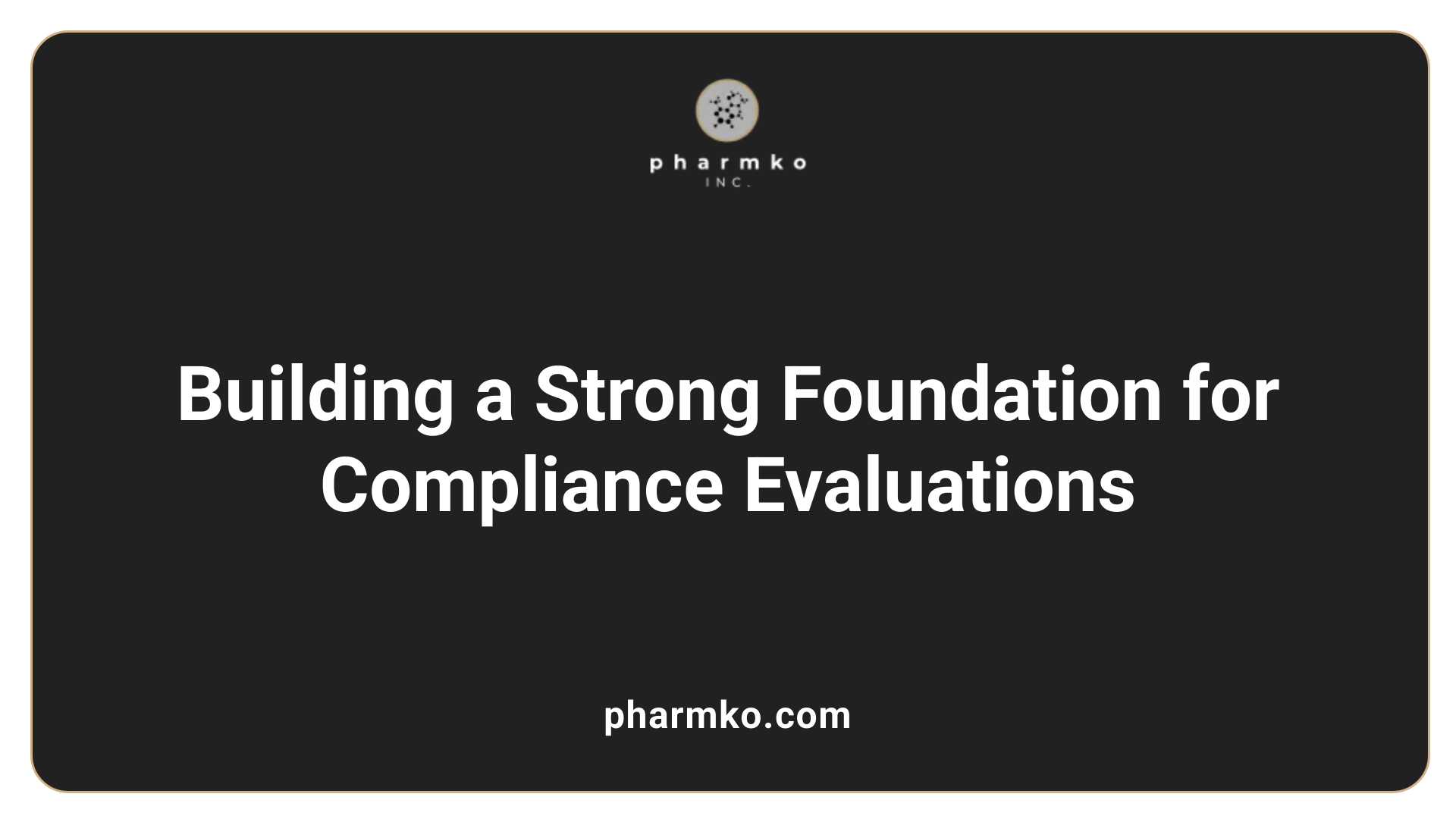
How do you evaluate adherence to industry standards and regulations?
Evaluating supplier compliance begins with a thorough review of their adherence to relevant industry standards and legal requirements. This involves verifying if they meet specific regulations such as HIPAA in healthcare, GDPR or CCPA for data privacy, and ESG laws like the UK Modern Slavery Act or the German Supply Chain Due Diligence Act.
Assessments should include analyzing policies, procedures, and operational practices to confirm they align with established standards. Regular audits—both desktop reviews and on-site inspections—are essential for verifying compliance in practice. Keeping track of certifications like ISO, CMMC, or NIST standards further demonstrates commitment and conformance.
Risk evaluations are performed through a combination of questionnaires, review of audit reports, and performance metrics, which help identify potential gaps or areas needing improvement. Implementing real-time monitoring tools and automatic alerts ensures ongoing compliance and quick detection of deviations.
What documentation and certifications should be reviewed?
Key documents include policies, procedures, audit reports, and certification certificates demonstrating compliance. For example, in cybersecurity, certificates like ISO 27001 or NIST compliance attest to security controls. In data privacy, GDPR or CCPA certifications, risk assessments, and data handling policies are crucial.
For industry-specific standards, reviewing licensing, registration, or accreditation certificates—such as CLIA for laboratories or CMS certifications for healthcare providers—is necessary. Contractual documents should specify compliance obligations, reporting requirements, and penalties for breaches.
Maintaining a centralized repository of all documentation simplifies ongoing oversight and facilitates audits. Regular updates and validation of certificates ensure they remain valid and applicable.
How are audits conducted and findings analyzed?
Audits are conducted both remotely and on-site, depending on risk level and materiality. On-site audits allow direct inspection of facilities, review of raw data, and verification of processes. Remote audits typically include document reviews, virtual walk-throughs, and interviews.
Findings are documented, categorized by severity (major or minor non-conformance), and analyzed to identify root causes. Corrective actions are assigned specific timelines and responsible persons.
Follow-up audits assess the effectiveness of corrective measures. Data from these audits are compiled into reports that inform ongoing compliance strategies.
Progress is tracked through dashboards displaying audit scores, non-conformance trends, and overdue corrective actions. This continuous analysis supports prompt resolution of issues and verifies sustained compliance.
What performance metrics are used to evaluate compliance?
Key performance indicators (KPIs) include defect rates, delivery timeliness, accuracy of documentation, incident and breach rates, and responsiveness to audits. Metrics like supplier defect rate directly impact quality assurance, while timeliness measures ensure operational efficiency.
Other useful metrics are compliance rates with regulatory requirements, number of non-conformances identified and resolved, and the time taken to implement corrective actions.
Setting clear thresholds for each metric helps organizations identify suppliers at risk and prioritize interventions. Regular reporting of these metrics fosters transparency and encourages continuous improvement.
How does a comprehensive assessment benefit compliance management?
A well-rounded compliance assessment guarantees that suppliers consistently meet regulatory expectations, reducing the risk of penalties, legal actions, and reputational damage. It fosters supplier accountability and promotes ethical practices.
Using digital platforms for data collection, analysis, and reporting streamlines the process, reduces errors, and enhances traceability. Combining audits with performance metrics and documentation reviews creates a robust framework for ongoing supplier oversight.
This integrated approach supports proactive risk management, ensuring supply chain resilience and compliance sustainability. Regular review cycles and adherence to international standards further strengthen the overall compliance posture.
| Aspect | Key Practices | Supporting Tools | Benefits |
|---|---|---|---|
| Evaluation | Review policies, conduct audits | Checklists, digital assessment platforms | Ensures adherence, identifies gaps |
| Documentation | Verify certifications, policies | Centralized document management | Maintains audit readiness |
| Auditing | Schedule and perform audits | On-site, remote auditing tools | Detects non-compliance, drives corrective actions |
| Performance Metrics | Measure defect rates, timeliness | Dashboards, KPI tracking software | Supports continuous improvement |
Adopting these core elements helps establish a culture of compliance, aligns supplier activities with regulatory standards, and ultimately protects organizations from compliance-related risks.
Developing an Effective Supplier Compliance Program
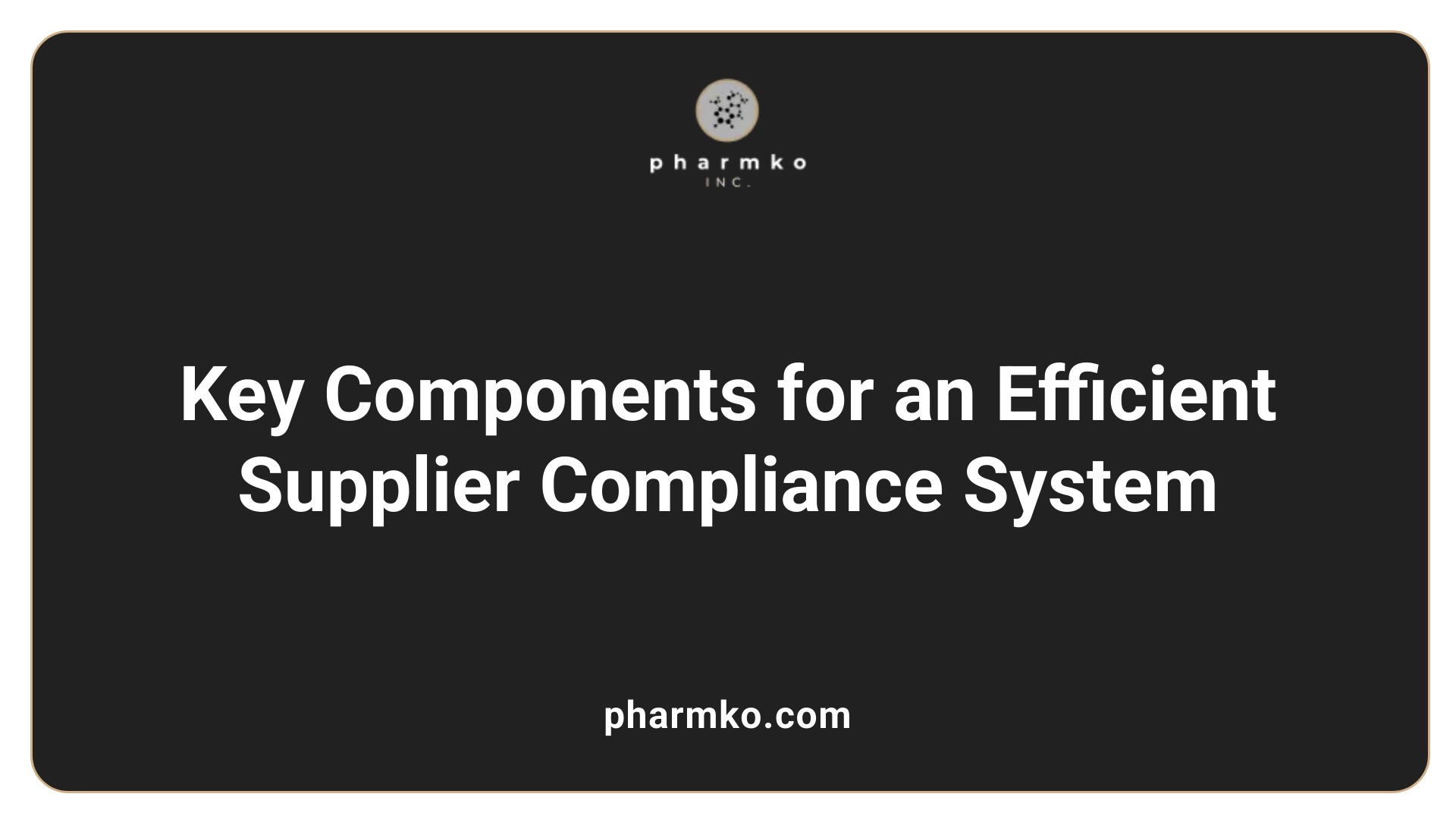
What are the key components of an effective supplier compliance program?
Creating a robust supplier compliance program involves several essential elements that work together to ensure suppliers meet all necessary legal, ethical, and operational standards.
Firstly, establishing clear policies, standards, and contractual requirements is fundamental. These policies should define expectations regarding quality, delivery, ethical practices, data security, and adherence to relevant regulations such as GDPR, CCPA, HIPAA, and ESG directives. Clear contractual clauses help enforce compliance and outline penalties for violations.
Regular monitoring and audit processes are equally vital. Routine assessments, including scheduled and surprise audits, enable organizations to verify supplier adherence to agreed-upon standards. Performance metrics, risk assessments, and ongoing due diligence help identify non-compliance issues early, minimizing potential disruptions.
Providing targeted training and resources to suppliers is another key component. Training programs educate suppliers on compliance expectations, regulatory requirements, and best practices. Resources such as compliance manuals, guidelines, and support channels empower suppliers to maintain standards.
Leveraging technology enhances the efficiency and transparency of compliance efforts. Supply chain management platforms, automated reporting tools, and data analytics help collect, monitor, and analyze compliance data in real time. These tools facilitate communication, documentation, and corrective action tracking.
Finally, a culture of continuous improvement is crucial. Staying updated with evolving industry standards, regulations, and best practices ensures the compliance program remains effective. Regular reviews and updates to policies, audit procedures, and training modules foster resilience and adaptability.
In summary, combining structured policies, ongoing monitoring, supplier education, technological support, and continuous evolution forms the backbone of a successful supplier compliance program. This integrated approach mitigates risks, ensures legal adherence, and promotes ethical standards across the supply chain.
| Component | Description | Additional Notes |
|---|---|---|
| Policies & Standards | Establish clear expectations and contractual obligations | Based on industry and regulatory requirements |
| Monitoring & Audits | Conduct regular evaluations of supplier performance | Use KPIs, audit reports, and risk assessments |
| Training & Resources | Provide educational tools and support | Helps suppliers understand compliance mandates |
| Technology & Data | Implement tools for real-time data tracking | Enhances transparency and efficiency |
| Continuous Improvement | Regularly update policies and practices | Adapts to industry changes and new risks |
Adopting these components enables organizations to manage supplier risks effectively, uphold compliance standards, and foster trustworthy supplier relationships.
Addressing Regulatory Risks and Conducting Due Diligence
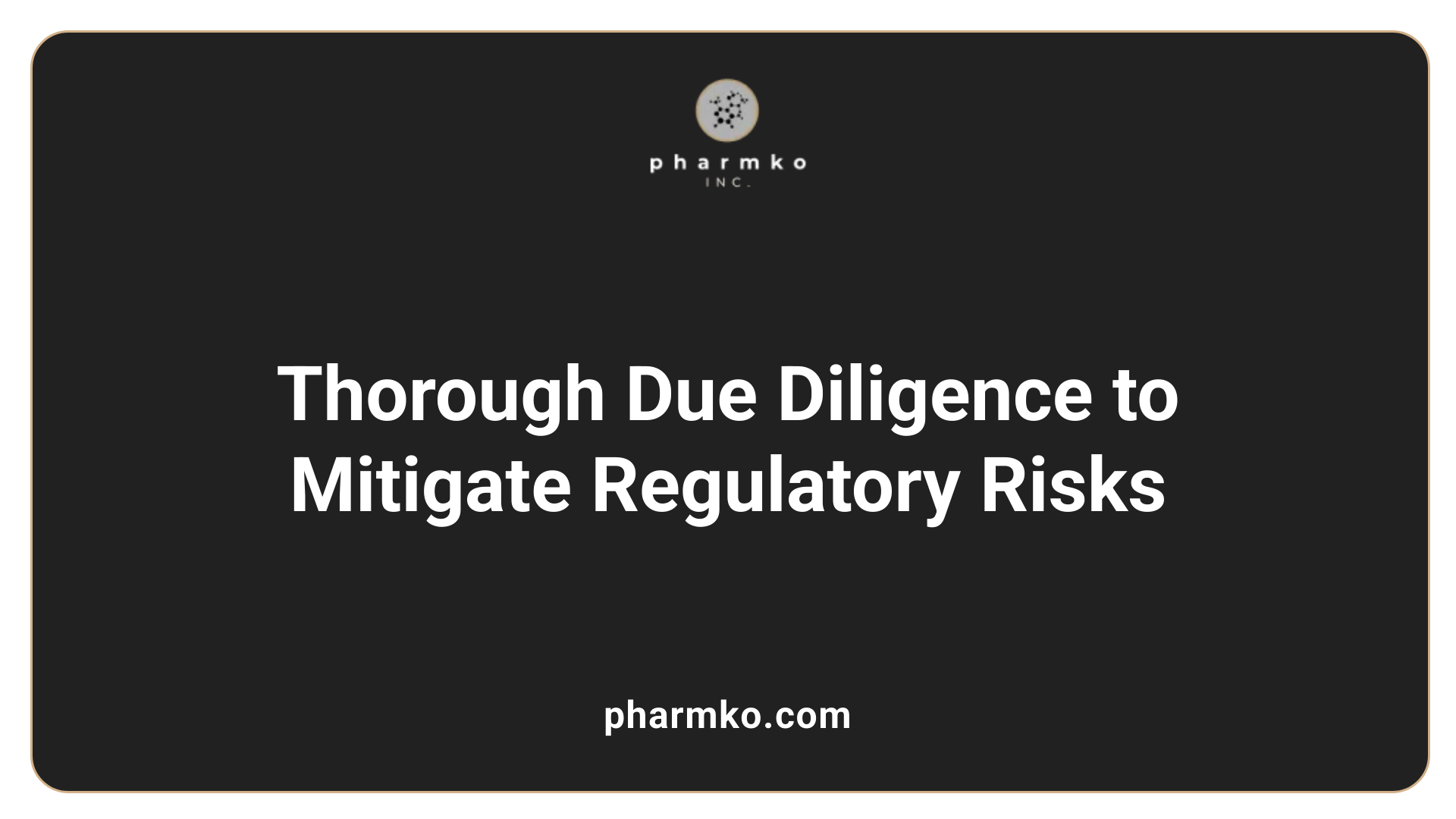
What are the essential criteria for assessing supplier compliance?
Assessing supplier compliance involves a comprehensive review of their adherence to relevant regulations, standards, and contractual commitments. The process starts with examining certifications, legal documents, and audit reports to verify that the supplier meets safety, quality, and operational standards.
It’s important to perform both desktop reviews of documentation and on-site audits when possible. These audits help identify non-conformances, whether major or minor, and check if suppliers are implementing corrective actions effectively.
Ongoing performance monitoring is also critical. Metrics such as delivery timeliness, defect rates, and compliance scores provide insight into the supplier's ability to maintain standards over time.
To improve the accuracy and consistency of these assessments, many organizations use checklists tailored to the specific industry and regulatory environment. Digital tools and platforms can further streamline data collection, analysis, and reporting, ensuring continuous compliance.
Proper documentation and transparent communication are essential for maintaining a clear record of compliance status and supporting continuous improvement efforts.
How should vendors be classified by risk level?
Vendors are typically segmented into high, medium, and low-risk categories based on their potential impact on the organization’s compliance and operational integrity. High-risk vendors usually handle sensitive data, critical functions, or operate in highly regulated industries.
Classifying vendors helps organizations prioritize due diligence efforts and resource allocation. High-risk vendors may require frequent audits, detailed questionnaires, and stricter contractual controls.
Medium-risk vendors may need periodic reviews and performance assessments, while low-risk vendors might be monitored through routine checks and basic compliance confirmation.
Effectively segmenting vendors allows organizations to focus their compliance activities where they are most needed and mitigate risks more efficiently.
How is the use of subject matter expert questionnaires helpful?
Questionnaires designed by subject matter experts (SMEs) serve as valuable tools for assessing a vendor’s compliance with specific regulations and standards. These questionnaires include targeted questions about cybersecurity practices, data security, environmental policies, and legal compliance.
Analyzing responses helps identify potential compliance gaps and areas of concern. This approach provides an objective measure of the vendor’s control environment and policy implementation.
Regularly updating these questionnaires ensures they reflect current regulatory requirements and emerging risks. They also enable organizations to compare vendors systematically and maintain a consistent evaluation process.
SME questionnaires are especially useful for onboarding new vendors, conducting risk assessments, and during periodic reviews to ensure ongoing compliance.
What role do internal and external risk assessments play?
Internal risk assessments involve analyzing the organization’s own processes and vendor relationships to identify compliance vulnerabilities. These assessments examine procurement procedures, audit histories, and previous incident reports.
External risk assessments focus on evaluating the vendor’s performance, financial stability, reputation, and compliance history through research, third-party audits, and public records.
Combining both internal and external assessments provides a holistic view of potential risks. This dual approach helps organizations develop targeted mitigation strategies and allocate oversight resources effectively.
Periodic risk assessments are essential for adapting to changing regulation landscapes, emerging threats, and operational shifts.
How can a legal and compliance review benefit vendor practices?
Performing a formal review of vendor practices from a legal and compliance standpoint ensures their operations align with applicable laws and contractual obligations. This review covers reviewing policies, contractual clauses, and documented procedures.
It verifies that vendors are compliant with industry standards and regulatory mandates, such as GDPR, HIPAA, or industry-specific cybersecurity standards.
Identifying gaps allows organizations to require corrective actions or renegotiate terms to enforce compliance. It also supports the development of clear contractual language relating to compliance responsibilities, audit rights, and penalties.
Regular legal and compliance reviews help organizations reduce their exposure to legal penalties, reputational damage, and operational disruptions. They also foster transparent and accountable vendor relationships, ultimately supporting a robust compliance framework.
Leveraging Regulatory Frameworks and Industry Standards
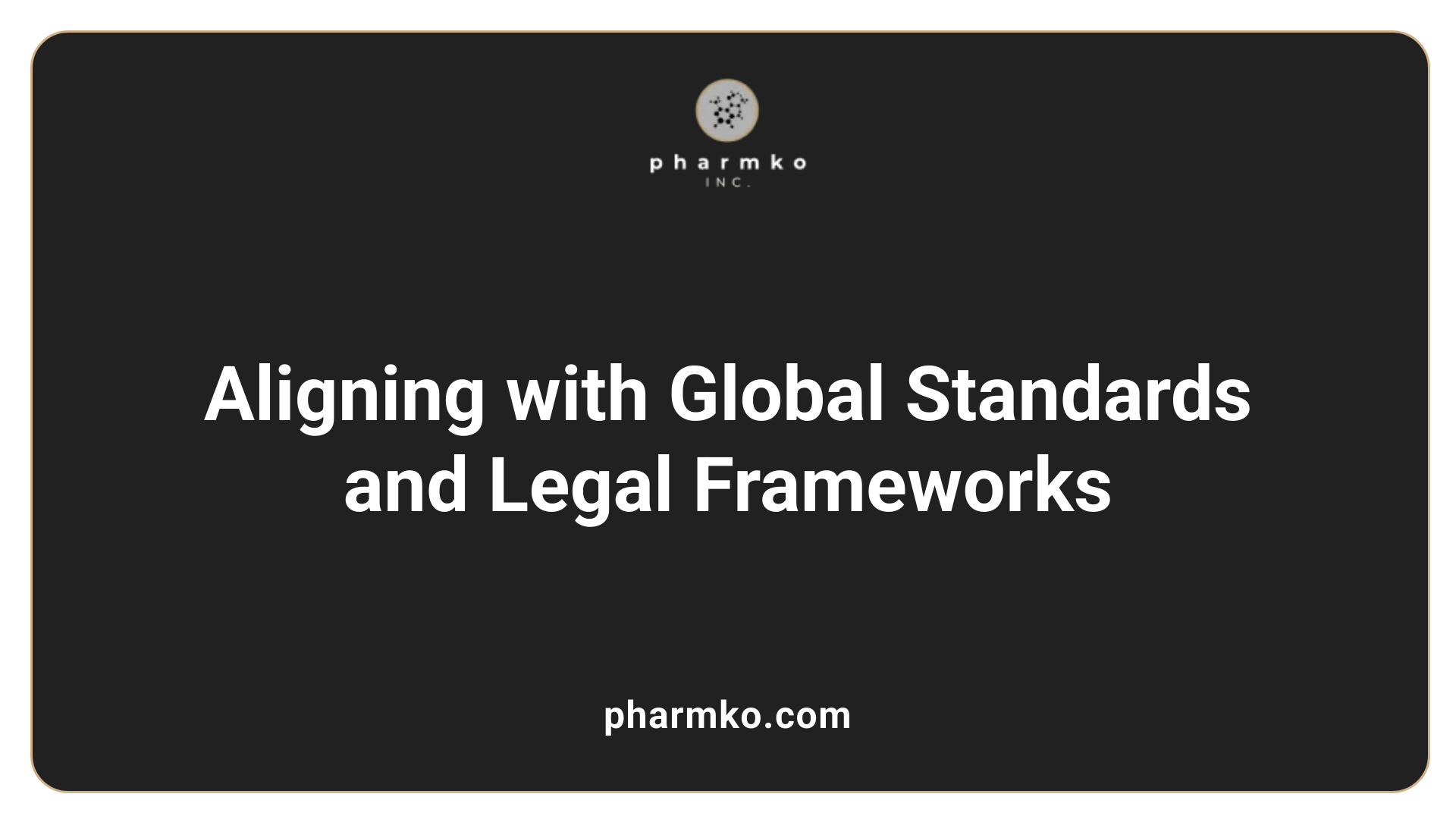
What does regulatory compliance entail for suppliers?
Regulatory compliance for suppliers involves strict adherence to all relevant laws, regulations, standards, and rules issued by government and industry authorities. These requirements often vary depending on the industry, geographic location, and the specific nature of goods or services provided.
Suppliers must establish comprehensive policies and procedures to meet these legal obligations. This includes conducting thorough risk assessments to identify areas of non-compliance and implementing controls to address them. Employee training programs are essential to ensure staff understand their responsibilities under these regulations.
Ongoing monitoring is vital for maintaining compliance. Regular audits and reviews help verify adherence and detect potential lapses before they lead to penalties or reputational damage. Leveraging compliance management tools, such as Governance, Risk, and Compliance (GRC) platforms, streamlines these efforts by providing real-time insights and automated workflows.
Adherence to standards like HIPAA for healthcare, GDPR and CCPA for data privacy, and industry-specific cybersecurity standards such as PCI DSS ensures that suppliers handle sensitive data responsibly. These standards also specify protocols for data transmission, storage, and reporting.
Managing compliance effectively not only avoids legal penalties, such as fines or sanctions, but also protects an organization from operational disruptions and reputational harm. It demonstrates a commitment to ethical practices, customer trust, and sustainable business operations.
To achieve sustained compliance, companies should continuously update their policies to reflect changes in laws and regulations. Incorporating industry best practices and international standards, including ISO standards, UN conventions, regional directives like the EU's directives, and national laws like the US Sarbanes-Oxley Act, further reinforces compliance efforts.
Ultimately, cultivating a culture of compliance across all levels of the organization fosters ongoing legal adherence and supports long-term business success in a competitive global marketplace.
How Do International Standards and Regional Regulations Intersect?
International standards such as ISO frameworks and UN conventions set globally recognized benchmarks for quality, security, and ethical practices. These standards often serve as foundational elements that support compliance with regional regulations.
For example, ISO 27001 provides a framework for information security management, aligning well with GDPR requirements on data protection. Similarly, UN Guiding Principles on Business and Human Rights guide companies in implementing responsible supply chain practices, supporting compliance with regional laws like the UK Modern Slavery Act or the German Supply Chain Due Diligence Act.
Regional directives and laws may impose specific obligations, such as mandatory reporting or certification processes, which complement international standards. Navigating these interconnected frameworks ensures that suppliers not only meet local legal mandates but also align with globally accepted best practices.
By integrating these standards into their operations, organizations can create a robust compliance ecosystem that enhances transparency, mitigates risks, and elevates their reputation across markets.
How Are Standards and Regulations Implemented and Monitored?
Effective implementation involves clearly defined procedures, documented policies, and assigned responsibilities tailored to each regulatory requirement.
Monitoring tools play a crucial role. Regular internal audits assess compliance status, while third-party assessments or certifications verify adherence externally. Performance metrics and key performance indicators (KPIs) are used to track ongoing compliance, identify gaps, and prioritize corrective actions.
Advanced technology solutions, such as automated reporting systems and real-time data analytics, support continuous monitoring. Platforms like Findings facilitate vendor compliance tracking by aggregating data, flagging deviations, and enabling prompt remediation.
Furthermore, organizations build compliance into their supply chain management by conducting due diligence, segmenting vendors based on risk levels, and establishing contractual clauses that enforce compliance.
Training employees regularly and fostering open communication channels encourage a proactive culture of compliance. When combined with robust oversight mechanisms and periodic reviews, these practices help organizations adapt swiftly to changing regulations and uphold high standards across all operations.
Summarizing Standards, Laws, and Regulatory Strategies
| Standard or Regulation | Scope | Main Focus | Implementation Tools | Notable Examples |
|---|---|---|---|---|
| ISO 27001 | Information security | Risk management, controls | Certification, audits | Data security management |
| UN Principles | Human rights, responsible business | Ethical supply chains | Corporate policies | UN Guiding Principles |
| GDPR | Data privacy (EU) | Personal data protection | Data Impact Assessments | Privacy Impact Reports |
| CCPA | Consumer data rights (California) | Data transparency and control | Consumer rights enforcement | Data access, deletion |
| UK Modern Slavery Act | Supply chain transparency | Combatting slavery | Due diligence reports | Supply chain audits |
| German Supply Chain Due Diligence Act | Human rights, social responsibility | Supply chain oversight | Compliance reports | Supplier investigations |
Who Is Responsible for Ensuring Compliance?
Overall accountability rests with senior leadership, including the Chief Compliance Officer, who oversees policies and monitors adherence. Departments such as legal, IT, procurement, and operations contribute to compliance efforts.
Suppliers are responsible for following the contractual and regulatory standards set forth, while regulators perform audits and inspections to verify compliance.
Organizations establish compliance committees to coordinate activities, ensure training, and respond to compliance issues swiftly. Regular reporting to executive boards ensures transparency and continuous improvement.
This collaborative approach creates a resilient compliance culture that supports long-term sustainability and legal adherence across the supply chain.
Conclusion: Cultivating a Culture of Compliance
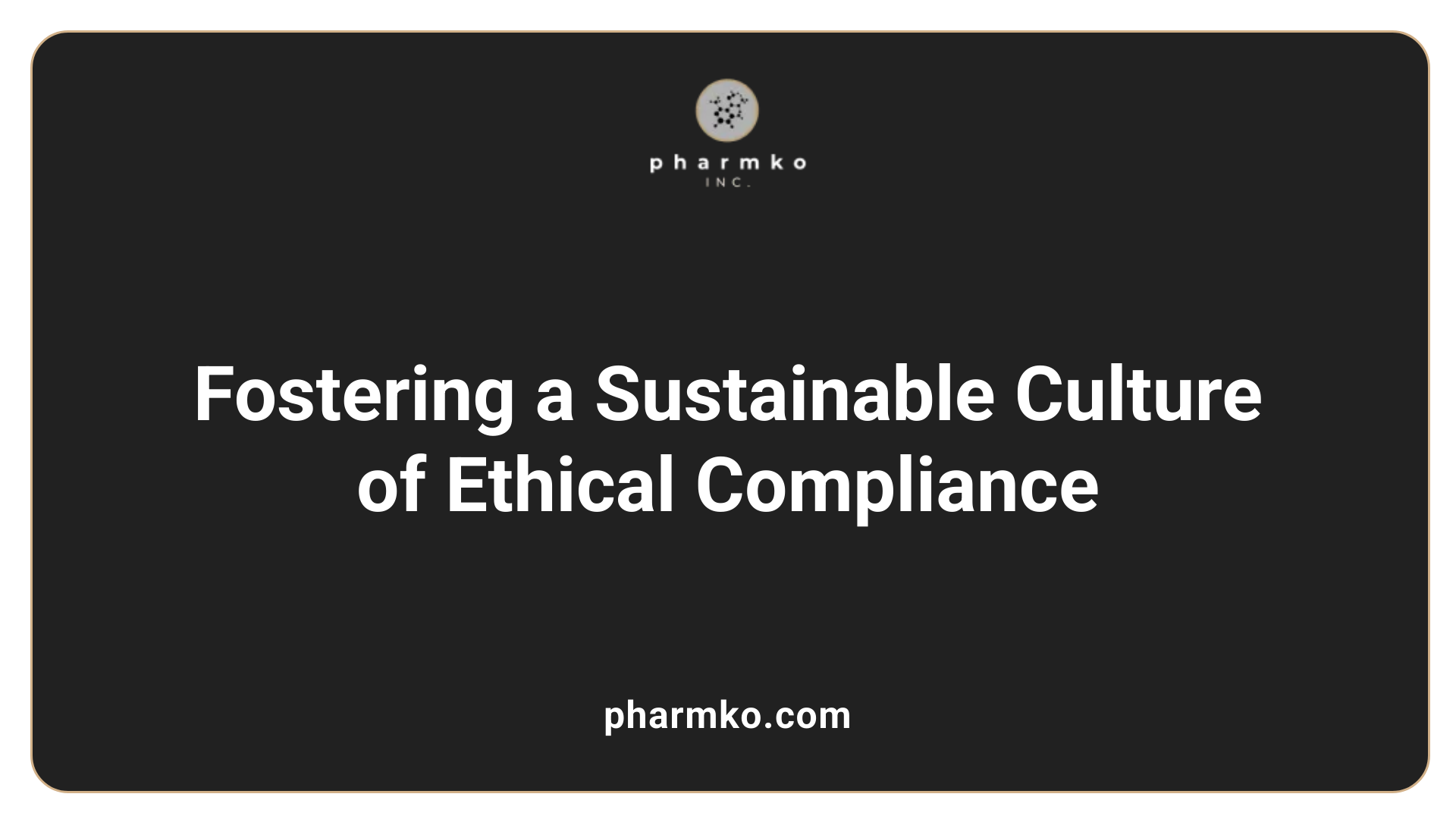
Why is ongoing monitoring and continuous improvement essential?
Maintaining compliance isn't a one-time effort; it requires regular oversight to adapt to evolving regulations and industry standards. Continuous monitoring allows organizations to identify potential gaps early, assess supplier performance consistently, and respond proactively. Implementing tools such as real-time data analytics and automated reporting can enhance transparency and operational efficiency. Regular audits, reviews, and assessments not only ensure adherence but also foster a proactive approach to compliance, fostering trust and reliability in the supply chain.
How do training and awareness programs support compliance?
Educating employees and suppliers about compliance obligations is fundamental. Training programs should cover relevant regulations, internal policies, and best practices, emphasizing the importance of ethical practices and legal adherence. Awareness initiatives, including workshops, e-learning modules, and updates on regulatory changes, help embed a compliance mindset throughout the organization. Well-informed teams are better equipped to recognize compliance risks, follow procedures accurately, and contribute to a culture where compliance is valued and upheld.
How can organizations align supplier performance with their standards?
Aligning supplier performance involves establishing clear expectations upfront through detailed contractual agreements that specify compliance requirements, reporting obligations, and consequences for non-compliance. Ongoing performance evaluation using KPIs, scorecards, and periodic audits ensures suppliers meet organizational and regulatory standards. Building collaborative relationships and providing support, such as training or resources, encourage suppliers to uphold high standards. Addressing issues promptly and consistently reinforces the importance of compliance and helps maintain quality, ethical, and operational integrity.
What role does leadership play in shaping a compliance culture?
Leaders set the tone at the top, demonstrating commitment to compliance through their actions and decision-making. They establish the strategic importance of compliance, allocate necessary resources, and enforce accountability across all levels of the organization. Leadership involvement in developing policies, supporting training initiatives, and responding to compliance issues underscores its significance. When leadership champions a culture of integrity and transparency, it motivates employees and suppliers to prioritize compliance, reducing risks and strengthening organizational reputation.
How do these elements come together?
An effective compliance culture integrates continuous improvement, education, performance management, and leadership support. This holistic approach ensures that compliance is ingrained in daily operations, supported by technology, reinforced through training, and driven by a strong leadership example.
| Aspect | Focus Area | Implementation Examples |
|---|---|---|
| Monitoring & Improvement | Regular reviews, audits, feedback mechanisms | Real-time analytics, periodic supplier evaluations, policy reviews |
| Training & Awareness | Education programs, updates on regulation changes | Workshops, e-learning modules, compliance newsletters |
| Performance Alignment | Clear standards, KPIs, contractual requirements | Supplier scorecards, KPI tracking, performance dashboards |
| Leadership Role | Setting tone, resource allocation, enforcement | Leadership-led training sessions, compliance reports, executive accountability meetings |
By fostering these interconnected elements, organizations can build a resilient compliance framework that not only mitigates risks but also promotes sustainable operational excellence. Practical integration of ongoing monitoring, continuous learning, performance oversight, and leadership commitment creates a culture where compliance is an inherent value, guiding every aspect of the supply chain.
Shaping a Future of Continuous Compliance
To maintain a resilient supply chain, organizations must embed compliance into their corporate culture through ongoing monitoring, education, and adaptive processes. Leadership must champion compliance initiatives, promote transparency, and leverage innovative tools to detect and address compliance gaps proactively. Only through diligent effort and continuous improvement can companies confidently ensure that their suppliers operate within all necessary regulatory parameters, safeguarding their reputation, minimizing risks, and fostering sustainable growth.
References
- Supplier Compliance: Key Regulations to Consider for Your SRM ...
- An Introductory Guide to Supplier Compliance - Stibo Systems
- Know Your Supplier (KYS): An Ultimate Guide for 2025 - KYC Hub
- Regulatory Compliance: Benefits and Best Practices to Keep Your ...
- How to Ensure Vendor Compliance in the US - Findings.co
- Vendor Compliance: Why It Matters and How to Achieve It
- Quality, Safety & Oversight -Certification & Compliance - CMS













